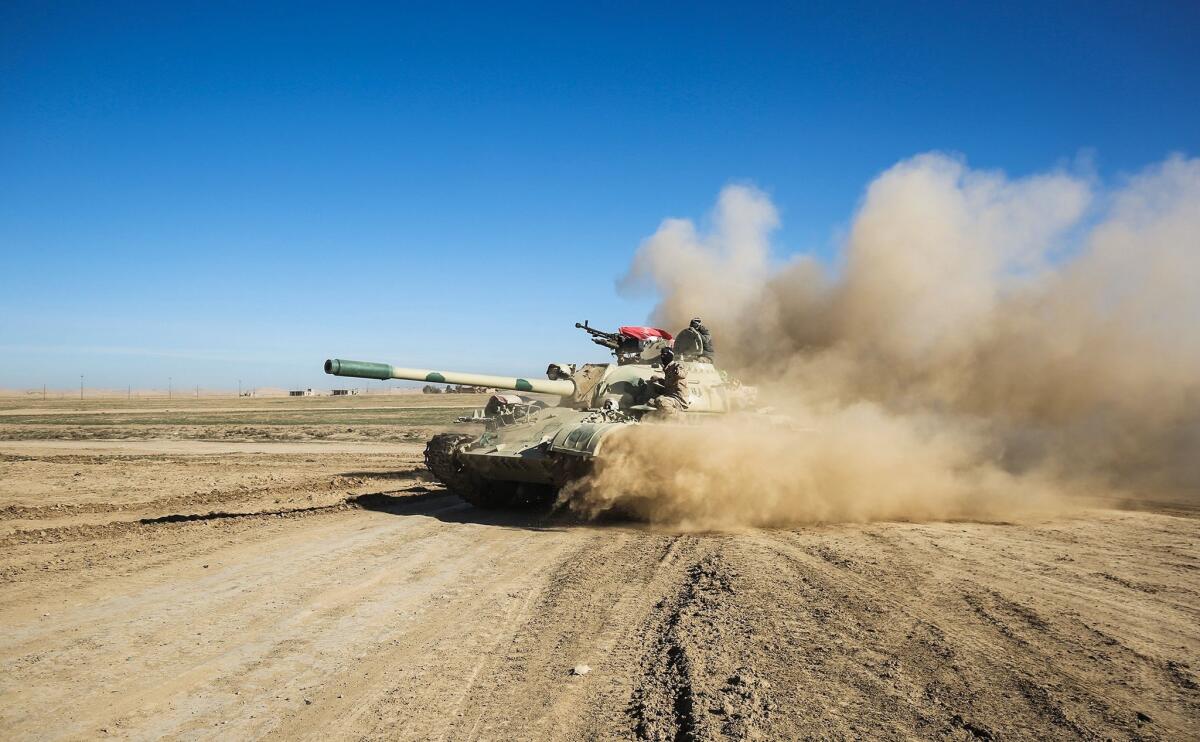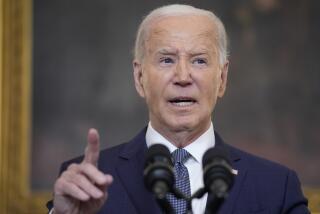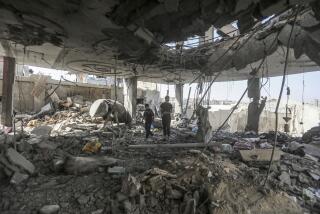Pentagon prepares to give the White House a stepped-up battle plan against Islamic State

Reporting from Washington — Pentagon strategists are putting final touches on a stepped-up battle plan against Islamic State and are due to offer President Trump options as early as Monday to accelerate the war against the militants in Iraq and Syria, officials said.
The month-long strategic review, which Trump requested Jan. 28, is expected to include proposals to send more U.S. troops to both countries, deploy more U.S. forces near the front lines, give greater authority to ground commanders, and possibly provide weapons to Kurdish YPG fighters in Syria.
Trump has vowed repeatedly to “defeat” Islamic State but has never spelled out what that means in a conflict with multiple countries backing competing factions in two separate wars — or how to ultimately stabilize the turbulent region.
Gen. Joseph F. Dunford Jr., chairman of the Joint Chiefs of Staff, warned Thursday that battlefield victories won’t be enough to end the threat of Islamic State and other extremist groups, especially in the multisided civil war in Syria.
“Anything we do on the ground has to be in the context of political objectives or it’s not going to be successful,” Dunford said at the Brookings Institution think tank in Washington.
“We need to think about how do the facts on the ground address the political process in Geneva,” where the United Nations backs peace talks between the Syrian government and opposition forces, he added.
Dunford suggested the Pentagon-led plan will also look at options to increase pressure on the Al Qaeda network and possibly the Haqqani group in Pakistan, which is aligned with the Taliban.
“This is not about Syria and Iraq,” he said. “This is about a trans-regional threat.”
While Defense Secretary James N. Mattis will present the review to the White House. It involved dialogue with key allies, coalition commanders and input from the departments of State, Treasury and Justice, as well as U.S. intelligence agencies.
The Pentagon has about 5,200 troops in Iraq, and the new plan assumes that Iraqi security forces and Kurdish militias will continue to take the lead in the fighting while the U.S.-led coalition coordinates airstrikes, fires artillery and collects intelligence to support the ground attack.
“As we look at the future, we’re going to continue to stand by the Iraqi army, the Iraqi people, who are fighting this enemy,” Mattis said Monday in Baghdad.
But it almost certainly involves sending more U.S. troops to speed military operations aimed at retaking western Mosul in Iraq and ultimately to pressing an offensive against Raqqah, the group’s self-declared capital in Syria.
“It could be that we take on a larger burden ourselves,” Gen. Joseph L. Votel, head of U.S. Central Command, told reporters in the region. “That’s an option.”
The U.S. role has expanded steadily since August 2014, when President Obama first approved airstrikes on Islamic State positions and sent troops back to Iraq, but vowed not to put “boots on the ground” in combat operations.
In December, Lt. Gen. Stephen Townsend, commander of U.S. forces in Iraq and Syria, ordered 450 U.S. military advisors to move closer to the front lines in eastern Mosul to help Iraqi forces that had bogged down, and had suffered heavy casualties, during two months of bitter urban fighting.
The U.S.-backed forces captured the area several weeks later and this month crossed the Tigris River and launched an assault on the city’s western half, where the militants are believed to be entrenched in a warren of narrow streets.
In a two-pronged strategy, coalition-backed Iraqi forces have steadily pushed Islamic State out of the cities, towns and oil fields they seized in 2014, while a separate array of military forces in Syria — including Russian-backed Syrian troops — have squeezed the group there as well.
U.S. analysts said they don’t expect the new plan to differ dramatically from the Obama administration’s approach, at least in Iraq.
“The existing strategy is working slowly but surely,” said Christopher Harmer, an analyst at the Institute for the Study of War, a nonpartisan public policy group.
Islamic State “is losing territory bit by bit so you might see changes around the edges, but it’s hard to imagine the administration will want to completely deviate from the current plan,” he added.
The challenge is tougher in Syria, where the Pentagon has about 500 troops and has backed the Syrian Democratic Forces, a coalition of rebel groups that operates chiefly in northern Syria.
Kurdish militias known as the YPG are the most capable part of the coalition. But Turkey, a U.S. ally, has angrily protested any U.S. attempts to arm the YPG, which it considers a terrorist force that seeks to carve out an independent Kurdish state in southern Turkey.
The Obama administration declined to arm the YPG, but Trump may decide to provide artillery, armored vehicles, machine guns and other weapons to help its fighters close in on Raqqah, Islamic State’s largest and most important stronghold in Syria.
Trump has also called for declaring and enforcing so-called safe zones for refugees in northern Syria. The Pentagon has opposed that strategy in the past because of the high expense of defending and supporting the areas, and the need for additional troops to secure them.
But establishing no-fly zones may give Trump credibility with Turkish President Recep Tayyip Erdogan, who has long urged the international community to create a buffer zone in Syria to help stem the flow of refugees into his country.
In his comments Thursday, Dunford said the plan being refined for Trump will be mindful of the internecine politics in the region and the complex war in Syria, which includes Iranian and Russian forces.
“Everything we do or fail to do will have second and third effects,” he said.
“At the end of the day, we cannot be paralyzed by tough choices,” Dunford said. “We have to frame those choices to the president and articulate the consequences of those choices and give him the chance to select one of those.”
Twitter: @wjhenn
ALSO:
Climate change is real: Just ask the Pentagon
Overweight, tattooed, stoned? The Pentagon may still want you
More to Read
Get the L.A. Times Politics newsletter
Deeply reported insights into legislation, politics and policy from Sacramento, Washington and beyond. In your inbox three times per week.
You may occasionally receive promotional content from the Los Angeles Times.











